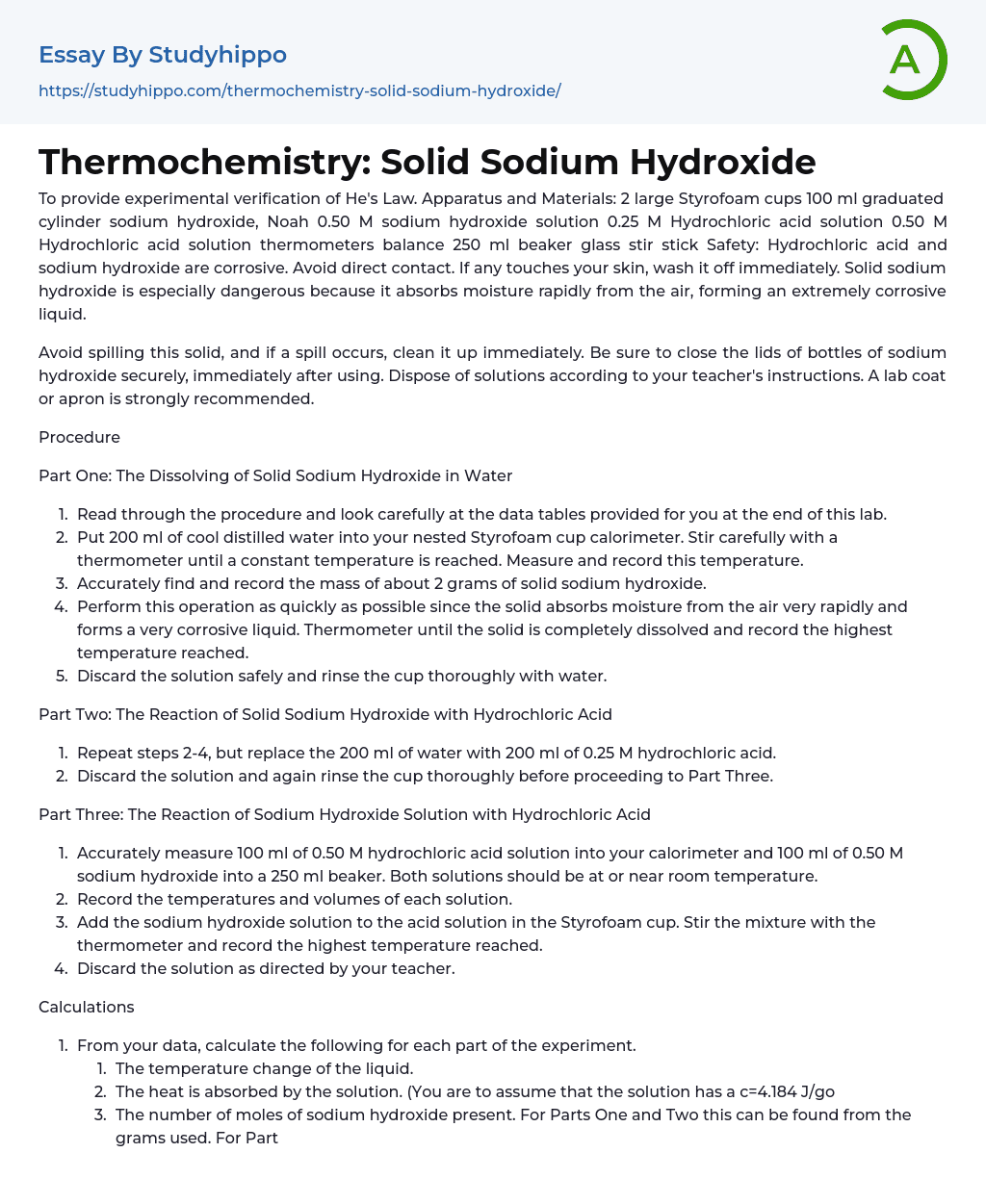To provide experimental verification of He's Law. Apparatus and Materials: 2 large Styrofoam cups 100 ml graduated cylinder sodium hydroxide, Noah 0.50 M sodium hydroxide solution 0.25 M Hydrochloric acid solution 0.50 M Hydrochloric acid solution thermometers balance 250 ml beaker glass stir stick Safety: Hydrochloric acid and sodium hydroxide are corrosive. Avoid direct contact. If any touches your skin, wash it off immediately. Solid sodium hydroxide is especially dangerous because it absorbs moisture rapidly from the air, forming an extremely corrosive liquid.
Avoid spilling this solid, and if a spill occurs, clean it up immediately. Be sure to close the lids of bottles of sodium hydroxide securely, immediately after using. Dispose of solutions according to your teacher's instructions. A lab coat or apron is strongly recommended.
Procedure
Part One: The Dissolving of Sol
...
id Sodium Hydroxide in Water
- Read through the procedure and look carefully at the data tables provided for you at the end of this lab.
- Put 200 ml of cool distilled water into your nested Styrofoam cup calorimeter. Stir carefully with a thermometer until a constant temperature is reached. Measure and record this temperature.
- Accurately find and record the mass of about 2 grams of solid sodium hydroxide.
- Perform this operation as quickly as possible since the solid absorbs moisture from the air very rapidly and forms a very corrosive liquid. Thermometer until the solid is completely dissolved and record the highest temperature reached.
- Discard the solution safely and rinse the cup thoroughly with water.
Part Two: The Reaction of Solid Sodium Hydroxide with Hydrochloric Acid
- Repeat steps 2-4, but replace the 200 ml of water with 200 ml of 0.25 M hydrochlori
View entire sample
Join StudyHippo to see entire essay
id Sodium Hydroxide in Water
- Read through the procedure and look carefully at the data tables provided for you at the end of this lab.
- Put 200 ml of cool distilled water into your nested Styrofoam cup calorimeter. Stir carefully with a thermometer until a constant temperature is reached. Measure and record this temperature.
- Accurately find and record the mass of about 2 grams of solid sodium hydroxide.
- Perform this operation as quickly as possible since the solid absorbs moisture from the air very rapidly and forms a very corrosive liquid. Thermometer until the solid is completely dissolved and record the highest temperature reached.
- Discard the solution safely and rinse the cup thoroughly with water.
Part Two: The Reaction of Solid Sodium Hydroxide with Hydrochloric Acid
- Repeat steps 2-4, but replace the 200 ml of water with 200 ml of 0.25 M hydrochlori
acid.
Part Three: The Reaction of Sodium Hydroxide Solution with Hydrochloric Acid
- Accurately measure 100 ml of 0.50 M hydrochloric acid solution into your calorimeter and 100 ml of 0.50 M sodium hydroxide into a 250 ml beaker. Both solutions should be at or near room temperature.
- Record the temperatures and volumes of each solution.
- Add the sodium hydroxide solution to the acid solution in the Styrofoam cup. Stir the mixture with the thermometer and record the highest temperature reached.
- Discard the solution as directed by your teacher.
Calculations
- From your data, calculate the following for each part of the experiment.
- The temperature change of the liquid.
- The heat is absorbed by the solution. (You are to assume that the solution has a c=4.184 J/go
- The number of moles of sodium hydroxide present. For Parts One and Two this can be found from the grams used. For Part Three the number of moles of sodium hydroxide is found from the malarial and the volume used.
- The amount of heat evolved per mole of sodium hydroxide used. This final value is the heat of the reaction.
- The accepted value for the heat of solution of sodium hydroxide can be found in a chemistry handbook. Compare your experimental value with this accepted value and calculate the experimental error.
Questions
- Add the ionic equations given in the introductions for Parts One and Three. Compare the result with the ionic equation for Part Two.
- Compare the sum of the heats of reaction for Parts One and Three with that obtained for Part Two. In the light of your
answer to Question 1, explain your results here.
- How would this have affected the change in temperature?
- What quantity of heat would have been evolved in your reaction?
- What effect would this have had on your calculation of the heat of reaction for Part One
- Atom essays
- Big Bang Theory essays
- Density essays
- Electricity essays
- Energy essays
- Force essays
- Heat essays
- Light essays
- Motion essays
- Nuclear Power essays
- Physiology essays
- Sound essays
- Speed essays
- Temperature essays
- Thermodynamics essays
- Acid essays
- Calcium essays
- Carbohydrate essays
- Carbon essays
- Chemical Bond essays
- Chemical Reaction essays
- Chemical reactions essays
- Chromatography essays
- Concentration essays
- Copper essays
- Diffusion essays
- Ethanol essays
- Hydrogen essays
- Organic Chemistry essays
- Osmosis essays
- Periodic Table essays
- Ph essays
- Salt essays
- Sodium essays
- Titration essays
- John Locke essays
- 9/11 essays
- A Good Teacher essays
- A Healthy Diet essays
- A Modest Proposal essays
- A&P essays
- Academic Achievement essays
- Achievement essays
- Achieving goals essays
- Admission essays
- Advantages And Disadvantages Of Internet essays
- Alcoholic drinks essays
- Ammonia essays
- Analytical essays
- Ancient Olympic Games essays




